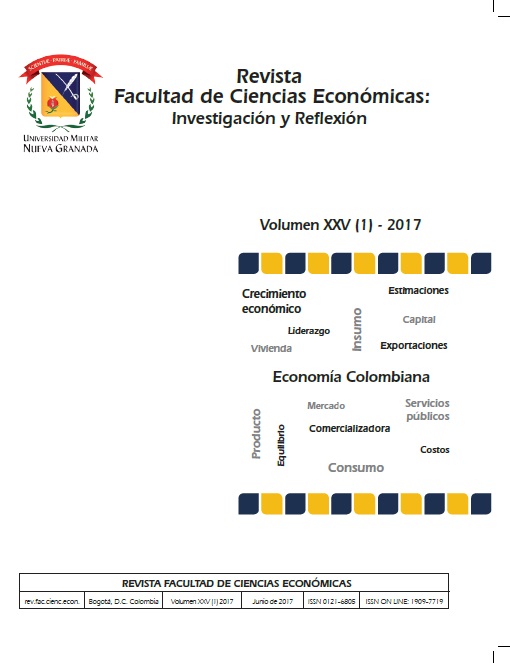Consumer behavior in the co-creation of value and its relationship with satisfaction in the university environment: an application to the University of Ibagué (Colombia)
Abstract
Academic contributions indicate that the consumer is the most important actor in the co-creation of value. But few studies have focused on discovering and check the influence of consumer behaviors that co-creates value in her/his satisfaction. Accordingly, this article contrasts this relationship in the university context for which a relational model with variables arises: consumer behavior in co-creating value and satisfaction. This model was applied to a representative sample of students from a Colombian university. The results show some positive relationships. The theoretical contribution of the study is that this is the first time the influence of co-creation is analyzed from the perspective of consumer satisfaction in the university context and in a Latin American country.Downloads
References
Ali, A., & Ahmmad, I. (2011). Key Factors for Determining Students’ Satisfaction in Distance Learning Courses: A Study of Allama Iqbal Open University. Contemporary Educational Tecchnology, 2(2), 118-134.
Andaleeb, S. S. (1996). An experimental investigation of satisfaction an commitment in marketing channels: the role of trust and dependence. Journal of Retailing, 72(1), 97-93.
Bagozzi, R., Baumgartner, H., & Yi, Y. (1992). State Versus action orientation and the theory of reasoned action: and application to couponusage. Journal of Consumer Research, 505-518.
Bettencourt, L. (1997). Customer voluntary performance: Customers as partners in service delivery. Journal of Retailing, 73(3), 383-406.
Borman, W., & Motowidlo, S. ((1993) 2014). Expanding the criterion domain to include elements of contextual performance. En N. Schmitt, & B. W. (ed.), Personnel selection in organization (págs. 71-98). San Francisco, California, Estados Unidos: Jossey-Bass.
Browne, M., & Cudeck, R. (1993). Alternative ways of assessing model fit. California, Estados Unidos: Sague Focus Editions.
Butt, B. Z. (2010). A study examining the students satisfaction in higher education. Procedia - Social and Behavioral Sciences., 2(2), 5446-5450.
Cardona, M., & Bravo, J. (2012). Service quality perceptions in higher education institutions: the case of a colombian university. Estudios Gerenciales, 28(125), 23-29.
Díaz, A. M., Suárez, L., & Vásquez, R. (2007). La confianza y la satisfacción del cliente. Revista europea de dirección y economía de la empresa, 16(3), 115-132.
Diaz, M., Taulet, A., Bonillo, M., & Fernández, R. (2014). Un enfoque de marketing de relaciones a la educaicón como un servicio: aplicación a la Universidad de Valecia. Revista de Ciencias administrativas y Sociales Innovar, 24(53), 113-125.
Durugbo, C., & Pawar, K. (2014). A unified model of the co-creation process. Expert Systems with Applications.
Elliott, K., & Shin, D. (2002). Student satisfaction: an alternative approach to assessing this important concept. Journal of Higher Education Policy and Management, 24(2), 197-209.
Fornell, C., & Larcker, D. (1981). Structural equation models with unobservable variables and measurement error: Algebra and statistics. Journal of Marketing research, 18(3), 382-388.
Ganesh, J., Arnold, M., & Reynolds, K. (2000). Understanding de costumer base of service providers: an examination of differences between switchers and staters. Journal Marketing, 64, 65-87.
Garbarino, E., & Johnson, M. (1999). The different roles of satisfaction, trust and commitment in consumer relationship. Internatinal Journal of Service Industry Management, 11(5), 470-490.
Giese, J., & Cote, J. (2000). Defining Consumer Satisfaction. Academy Of marketing science review., 1(1), 1-22.
Grönroos, C. (2008). Service logic revisited: ¿who creates value?, and ¿who co‐creates? European Business Review, 20(4), 298-314.
Grönroos, C. (2011). Value co-creation in service logic: A critical analysis. Marketing Theory, 11(3), 279-301.
Grönroos, C., & Voima, P. (2013). Critical service logic: making sense of value creation and co-creation. Journal of the Academy of Marketing Science, 41(2), 133-150.
Groth, M. (2005). Customers as Good Soldiers:Examining Citizenship Behaviors. Journal of Management(31), 7-27.
Hair, J. F., Anderson, R. E., Tatham, R. L., Black, W. C., & Babin, B. (1998). Multivariate data analysis with readings. Sydney, Australia: Prentice Hall.
Helgesen, O., & Nesset, E. (2007). Images, satisfaction and antecedents: ¿Drivers of student loyalty? A Case study of a Norwegian University College. Corporate Reputation Review,, 10(1), 38-59.
Hu, L., & Bentler, P. (1999). Cutoff criteria for fit indexes in covariance structure analysis: Conventional criteria versus new alternatives. A Multidisciplinary Journal, 6(1), 1-55.
Hunt, D., Geiger-Oneto, S., & Varca, P. (2012). Satisfaction in the context of customer co‐production: a behavioral involvement perspective. Journal of Consumer Behaviour, 11(5), 347-356.
Jurkowitsch, Vignali, & Kaufmann. (2006). A student satisfaction model for Austrian higher education providers considering aspects of marketing communications. Innovative Marketing, 3 (Special Edition).
Mattila, A., & Wirtz, J. (2000). The rol of preconsumption affect in postpurchase evaluation of servicer. Psichology & Marketing, 17(7), 586-605.
Nunnally, J., & Bernstein, I. (1994). Psychometric Theory. New York, New York, Usa: McGraw-Hill.
Palacio, A., Meneses, G., & Pérez, P. (2002). The configuration of the university image and its relationship with the satisfaction of students. Journal of Educational Administration, 40(5), 486-504.
Payne, Storbacka, & Frow. (2008). Managing the co-creation of value. Academy of Marketing Science, 36(1), 83-96.
Ping, R. (1997). Voice in business to business relationships: cost of exit and demographics antecedentes. Jounal of Retailing, 75(2), 261-281.
Prahalad, C., & Ramaswamy, C. (2004). Co-creation experiences: The next practice in value creation. Journal of interative marketing., 18(3), 5-14.
Schlesinger, M. W., Cervera Taulet, A., Iniesta Bonillo, M. Á., & Sánchez Fernández, R. (2014). Un enfoque de marketing de relaciones a la educación como un servicio: aplicación a la Universidad de Valencia. Revista de Ciencias administrativas y Sociales Innovar, 24(53), 113-125.
Schumacker, R. E., & Lomax, R. G. (1996). A beginner's guide to structural equation modeling. New Jersey, New Jersey, USA: Paperback.
Sharma, N., & Patterson, P. (2000). Switching cost, alternative atractivenees and experience as moderator of relationship commitent in professional, consumer service. International Journal of Service Industry Management, 11(5), 470-490.
Sivadas, E., & Baker-Previtt, J. (2000). An examination of the relationship between service quality, costumer, satisfaction and store loyalty. International Journal of Bank Marketing, 16(1), 1-16.
Söderlund, M. (1998). Customer satisfaction and its consequences on consumer behaviour. International Journal of Retail and Distribution Management, 28(2), 73-82.
Suárez, L., Vázquez, R., & Díaz, A. (2007). La confianza y la satisfacción del cliente:. Revista europea de dirección y economía de la empresa, 16(3), 115-132.
Vanhamme, J., & Snelders. (2001). The role of surprise in satisfaction judgments. Journal of consumer satisfaction dissatisfation and complaning behavior (14), 27-45.
Vargo, S., & Lusch, R. (2004). Envolving to a new dominant logic for marketing. Journal of marketing, 1-17.
Vargo, S., Maglio, P., & Akaka, M. (2008). On value and value co-creation: A service systems. European management Journal, 26(3), 145-152.
Vega, Revilla, & Cossío. (2013). The value co-creation process as a determinant of customer satisfaction. Management Decision, 51(19), 1945-1953.
Yi, Y., & Gong, T. (09 de 2013). Customer value co-creation behavior: scale development and validation. Journal of Business Research, 66(9), 1279-1284.
Yi, Y., Nataraajan, R., & Gong, T. (2011). Customer participation and citizenship behavioral influences on employee performance, satisfaction, commitment, and turnover intention. Journal of Business Research, 64, 87-95.
Zineldin, Akdag, & Vasicheva. (2011). Assessing quality in higher education: new criteria for evaluating students’ satisfaction. Quality in Higher Education, 17(2), 231-243.











